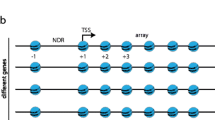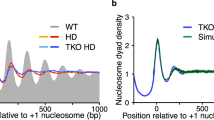Abstract
Genome-wide nucleosome mapping in vivo highlighted the extensive degree of well-defined nucleosome positioning. Such positioned nucleosomes, especially in promoter regions, control access to DNA and constitute an important level of genome regulation. However, the molecular mechanisms that lead to nucleosome positioning are far from understood. In order to dissect this mechanism in detail with biochemical tools, an in vitro system is necessary that can generate proper nucleosome positioning de novo. We present a protocol that allows the assembly of nucleosomes with very much in vivo-like positioning on budding yeast DNA, either of single loci or of the whole-genome. Our method combines salt gradient dialysis and incubation with yeast extract in the presence of ATP. It provides an invaluable tool for the study of nucleosome positioning mechanisms, and can be used to assess the relative stability of properly positioned nucleosomes. It may also generate more physiological templates for in vitro studies of, e.g., nucleosome remodeling or transcription through chromatin.
Access this chapter
Tax calculation will be finalised at checkout
Purchases are for personal use only
Similar content being viewed by others
References
Radman-Livaja, M. and Rando, O. J. (2010) Nucleosome positioning: how is it established, and why does it matter? Dev. Biol. 339, 258–266.
Segal, E. and Widom, J. (2009) What controls nucleosome positions? Trends Genet. 25, 335–343.
Jiang, C. and Pugh, B. F. (2009) Nucleosome positioning and gene regulation: advances through genomics Nat. Rev. Genet. 10, 161–172.
Yuan, G. C., Liu, Y. J., Dion, M. F., Slack, M. D., Wu, L. F., Altschuler, S. J., and Rando, O. J. (2005) Genome-scale identification of nucleosome positions in S. cerevisiae Science 309, 626–630.
Mavrich, T. N., Jiang, C., Ioshikhes, I. P., Li, X., Venters, B. J., Zanton, S. J., Tomsho, L. P., Qi, J., Glaser, R. L., Schuster, S. C., Gilmour, D. S., Albert, I., and Pugh, B. F. (2008) Nucleosome organization in the Drosophila genome Nature 453, 358–362.
Valouev, A., Ichikawa, J., Tonthat, T., Stuart, J., Ranade, S., Peckham, H., Zeng, K., Malek, J. A., Costa, G., McKernan, K., Sidow, A., Fire, A., and Johnson, S. M. (2008) A high-resolution, nucleosome position map of C. elegans reveals a lack of universal sequence-dictated positioning Genome Res. 18, 1051–1063.
Schones, D. E., Cui, K., Cuddapah, S., Roh, T. Y., Barski, A., Wang, Z., Wei, G., and Zhao, K. (2008) Dynamic regulation of nucleosome positioning in the human genome Cell 132, 887–898.
Lee, W., Tillo, D., Bray, N., Morse, R. H., Davis, R. W., Hughes, T. R., and Nislow, C. (2007) A high-resolution atlas of nucleosome occupancy in yeast Nat. Genet. 39, 1235–1244.
Lantermann, A. B., Straub, T., Stralfors, A., Yuan, G. C., Ekwall, K., and Korber, P. (2010) Schizosaccharomyces pombe genome-wide nucleosome mapping reveals positioning mechanisms distinct from those of Saccharomyces cerevisiae Nat. Struct. Mol. Biol. 17, 251–257.
Stein, A. (1989) Reconstitution of chromatin from purified components Methods Enzymol. 170, 585–603.
Rhodes, D. and Laskey, R. A. (1989) Assembly of nucleosomes and chromatin in vitro Methods Enzymol. 170, 575–585.
Luger, K., Rechsteiner, T. J., and Richmond, T. J. (1999) Expression and purification of recombinant histones and nucleosome reconstitution Methods Mol. Biol. 119, 1–16.
Widom, J. (2001) Role of DNA sequence in nucleosome stability and dynamics Q. Rev. Biophys. 34, 269–324.
Schnitzler, G. R. (2008) Control of nucleosome positions by DNA sequence and remodeling machines Cell Biochem. Biophys. 51, 67–80.
Kaplan, N., Moore, I. K., Fondufe-Mittendorf, Y., Gossett, A. J., Tillo, D., Field, Y., LeProust, E. M., Hughes, T. R., Lieb, J. D., Widom, J., and Segal, E. (2009) The DNA-encoded nucleosome organization of a eukaryotic genome Nature 458, 362–366.
Zhang, Y., Moqtaderi, Z., Rattner, B. P., Euskirchen, G., Snyder, M., Kadonaga, J. T., Liu, X. S., and Struhl, K. (2009) Intrinsic histone-DNA interactions are not the major determinant of nucleosome positions in vivo Nat. Struct. Mol. Biol. 16, 847–852.
Pugh, B. F. (2010) A preoccupied position on nucleosomes Nat. Struct. Mol. Biol. 17, 923.
Kaplan, N., Hughes, T. R., Lieb, J. D., Widom, J., and Segal, E. (2010) Contribution of histone sequence preferences to nucleosome organization: proposed definitions and methodology Genome Biol. 11, 140.
Simpson, R. T. and Stafford, D. W. (1983) Structural features of a phased nucleosome core particle Proc. Natl. Acad. Sci. USA 80, 51–55.
Neubauer, B., Linxweiler, W., and Hörz, W. (1986) DNA engineering shows that nucleosome phasing on the African green monkey alpha-satellite is the result of multiple additive histone-DNA interactions J. Mol. Biol. 190, 639–645.
Lowary, P. T. and Widom, J. (1998) New DNA sequence rules for high affinity binding to histone octamer and sequence-directed nucleosome positioning J. Mol. Biol. 276, 19–42.
Lusser, A. and Kadonaga, J. T. (2004) Strategies for the reconstitution of chromatin Nat. Methods 1, 19–26.
Pazin, M. J., Bhargava, P., Geiduschek, E. P., and Kadonaga, J. T. (1997) Nucleosome mobility and the maintenance of nucleosome positioning. Science 276, 809–812.
Langst, G., Becker, P. B., and Grummt, I. (1998) TTF-I determines the chromatin architecture of the active rDNA promoter EMBO J. 17, 3135–3145.
Robinson, K. M. and Schultz, M. C. (2003) Replication-independent assembly of nucleosome arrays in a novel yeast chromatin reconstitution system involves antisilencing factor Asf1p and chromodomain protein Chd1p Mol. Cell. Biol. 23, 7937–7946.
Schultz, M. C. (1999) Chromatin assembly in yeast cell-free extracts Methods 17, 161–172.
Schultz, M. C., Hockman, D. J., Harkness, T. A., Garinther, W. I., and Altheim, B. A. (1997) Chromatin assembly in a yeast whole-cell extract Proc. Natl. Acad. Sci. USA 94, 9034–9039.
Hertel, C. B., Längst, G., Hörz, W., and Korber, P. (2005) Nucleosome stability at the yeast PHO5 and PHO8 promoters correlates with differential cofactor requirements for chromatin opening Mol. Cell. Biol. 25, 10755–10767.
Wippo, C. J., Krstulovic, B. S., Ertel, F., Musladin, S., Blaschke, D., Sturzl, S., Yuan, G. C., Hörz, W., Korber, P., and Barbaric, S. (2009) Differential cofactor requirements for histone eviction from two nucleosomes at the yeast PHO84 promoter are determined by intrinsic nucleosome stability Mol. Cell. Biol. 29, 2960–2981.
Zhang, Z., Wippo, C. J., Wal, M., Ward, E., Korber, P., and Pugh, B. F. (2011) A packing mechanism for nucleosome organization reconstituted across a eukaryotic genome. Science 332, 977–980.
Ertel, F., Dirac-Svejstrup, A. B., Hertel, C. B., Blaschke, D., Svejstrup, J. Q., and Korber, P. (2010) In vitro reconstitution of PHO5 promoter chromatin remodeling points to a role for activator-nucleosome competition in vivo Mol. Cell. Biol. 30, 4060–4076.
Patterton, H. G. and von Holt, C. (1993) Negative supercoiling and nucleosome cores. I. The effect of negative supercoiling on the efficiency of nucleosome core formation in vitro J. Mol. Biol. 229, 623–636.
Simon, R. H. and Felsenfeld, G. (1979) A new procedure for purifying histone pairs H2A + H2B and H3 + H4 from chromatin using hydroxylapatite Nucleic Acids Res. 6, 689–696.
Svaren, J., Venter, U., and Hörz, W. (1995) In vivo analysis of nucleosome structure and transcription factor binding in Saccharomyces cerevisiae Methods in Mol. Genet. 6, 153–167.
Sambrook, J., Fritsch, E. F., and Maniatis, T. (1989) Molecular Cloning: A Laboratory Manual (Edition) Cold Spring Harbor Laboratory Press, Cold Spring Harbor, NY.
Wippo, C. J., Israel, L., Watanabe, S., Hochheimer, A., Peterson, C. L., and Korber, P. (2011) The RSC chromatin remodelling enzyme has a unique role in directing the accurate positioning of nucleosomes EMBO J. 30, 1277–1288.
Germond, J. E., Hirt, B., Oudet, P., Gross-Bellark, M., and Chambon, P. (1975) Folding of the DNA double helix in chromatin-like structures from simian virus 40 Proc. Natl. Acad. Sci. USA 72, 1843–1847.
Pfaffle, P. and Jackson, V. (1990) Studies on rates of nucleosome formation with DNA under stress J. Biol. Chem. 265, 16821–16829.
Nightingale, K. P. and Becker, P. B. (1998) Structural and functional analysis of chromatin assembled from defined histones Methods A Companion To Methods In Enzymology 15, 343–353.
Huynh, V. A., Robinson, P. J., and Rhodes, D. (2005) A method for the in vitro reconstitution of a defined “30 nm” chromatin fibre containing stoichiometric amounts of the linker histone J. Mol. Biol. 345, 957–968.
Korber, P. and Hörz, W. (2004) In vitro assembly of the characteristic chromatin organization at the yeast PHO5 promoter by a replication-independent extract system J. Biol. Chem. 279, 35113–35120.
Acknowledgments
Work in our laboratory is funded by the German Research Community (DFG, grant within the SFB/Transregio 5) and through the 6th Framework Programme of the European Community (NET grant within the Network of Excellence The Epigenome). We thank Nils Krietenstein for critical reading of the manuscript. This paper is dedicated to the memory of Eduard Buchner, who founded biochemistry by demonstrating the power of yeast extracts.
Author information
Authors and Affiliations
Corresponding author
Editor information
Editors and Affiliations
Rights and permissions
Copyright information
© 2012 Springer Science+Business Media, LLC
About this protocol
Cite this protocol
Wippo, C.J., Korber, P. (2012). In Vitro Reconstitution of In Vivo-Like Nucleosome Positioning on Yeast DNA. In: Morse, R. (eds) Chromatin Remodeling. Methods in Molecular Biology, vol 833. Humana Press. https://doi.org/10.1007/978-1-61779-477-3_17
Download citation
DOI: https://doi.org/10.1007/978-1-61779-477-3_17
Published:
Publisher Name: Humana Press
Print ISBN: 978-1-61779-476-6
Online ISBN: 978-1-61779-477-3
eBook Packages: Springer Protocols




